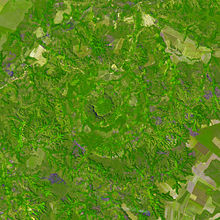Serra da Cangalha
The Serra da Cangalha is an impact crater in northeast Brazil in the state of Tocantins near the border with the state of Maranhão ( 8 ° 5 ′ S , 46 ° 52 ′ W, ).
The crater is 12 to 13 km in diameter, making it the second largest known crater in Brazil. Its age is estimated to be around 220 million years ( Triassic period ). The name means pack saddle mountains in Portuguese .
description
The outer ring is a circular, inwardly directed steep slope with a diameter of around 12 km on largely untouched chalk and upper Silurian sediments of the Parnaíba basin , with gaps in the west, north and south through river valleys. Within the outer ring there are a series of concentric, circular valleys and a central basin, all of about the same height, separated by ring-shaped ramparts. SRTM images show a faint ring about 11 km in diameter, a second ring of flat mounds 5-6 km in diameter, and an inner ring of steeper mounds about 3 km in diameter and up to 420 m in height that is open to the northwest and a central basin around 2.2 km in diameter.
The origin of an impact is attested by the presence of impact breccias , quartzite cones and shocked quartz. It is believed that the meteorite hit the earth's surface at a shallow angle of 25-30 degrees on dry land. Radial faults exist within the crater, and some extend up to 10 miles from the center. Disturbed and steeply sloping sediments from the Carboniferous and Devonian periods can be found within the crater. A magnetic analysis of the structure showed that the deformation within the crater extends to a depth of approximately 2 km.
History and studies
The identification of the structure as an impact crater was first established in 1973 by RS Dietz and BM French . Cones of rays were found by Beatty in 1980. Impact breccias, impact melt and shocked quartz were mentioned by McHone in his 1986 thesis. A magnetic study of the structure was published by AA Adepelumi and others in 2005.
Individual evidence
- ↑ Serra da Cangalha ( Memento from March 4, 2016 in the Internet Archive ). Earth Impact Database
- ↑ McHone, J F .; Dietz, R S .: Earth's multiple impact craters and astroblemes (abstract) . In: Lunar and Planetary Institute (ed.): XXIII Lunar and Planetary Science . Houston 1992, p. 887-888 , bibcode : 1992LPI .... 23..887M .
- ↑ a b R. Almeida Filho, FR Moreira; CHBeisl: The Serra da Cangalha astrobleme as revealed by ASTER and SRTM orbital data Archived from the original on July 6, 2011. In: International Journal of Remote Sensing . 24, pp. 1-6. Retrieved September 24, 2007.
- ↑ a b R. Gregio: Cratera da Serra da Cangalha . Archived from the original on September 30, 2007. Retrieved September 24, 2007.
- ↑ a b c Adepelumi, AA, Fontes, SL; Schnegg, PA; Flexor, JM: An integrated magnetotelluric and aeromagnetic investigation of the Serra da Cangalha impact crater, Brazil . In: Physics of the Earth and Planetary Interiors . 150, No. 1, 2005, pp. 159-182. bibcode : 2005PEPI..150..159A . doi : 10.1016 / j.pepi.2004.08.029 .
- ^ A b WU Reimold: A SRTM Investigation of Serra da Cangalho [sic] Impact Structure, Brazil . In: Lunar and Planetary Science XXXV ..
- ↑ W. Masero, P.-A. Schnegg; SL Fontes: Magnetotelluric investigation of the Serra da Cangalha impact crater, Northeast Brazil . In: . September.
- ↑ Adekunle Adepelumi: A magnetotelluric investigation of the Serra da Cangalha impact crater structure, Brazil . .
- ^ Dietz, RS, French, BM: Two probable astroblemes in Brazil . In: Nature . 244, No. 5418, 1973, pp. 561-562. bibcode : 1973Natur.244..561D . doi : 10.1038 / 244561a0 .
- ↑ Crosta, AP : Impact structures in Brazil . In: Friedrich, Vieweg & Sohn (Ed.): Research in Terrestrial Impact Structures . 1987, pp. 30-38.
- ^ Beatty JK: Crater hunting in Brazil . In: Sky and Telescope . 59, 1980, pp. 464-467. bibcode : 1980S & T .... 59..464B .
- ↑ McHone JF: Terrestrial structures impact: Their detection and verification with new examples from Brazil . University of Illinois at Urbana-Champaign, Urbana, Illinois, 1986, p. 210.
